An easy hike to a hidden historic site.
Difficulty: Easy
Distance: 1.1 miles round trip
Elevation gain: 60 feet
Time: 1 hour
Distance: 1.1 miles round trip
Elevation gain: 60 feet
Time: 1 hour
Categories: February, Hike of the Month, Tunis Mill Lot
Tags: erratic, mill, moose
Hike Directions & Map – Full PDF
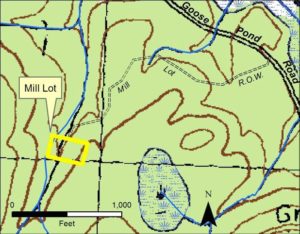 Driving Directions
Driving Directions
- From Route 10 north of town, turn R onto Goose Pond Road and set your odometer.
- Drive E on Goose Pond Rd. 5.4 miles (1.6 miles from where pavement ends for the second time).
- Find the trailhead on the south side of Goose Pond Road, marked with a green Conservancy sign and red flagging. It is nearly opposite a gate bearing a yellow sign reading “Private Road – Bear Hill Reservation.” If you reach a large roadside pulloff on the R, you’ve gone too far.
- Please park as far off Goose Pond Road as possible, and do not block the gate.
- Today’s hike, shown on the map above, is an out-and-back trip to an historic site in the woods.
What You Should Know
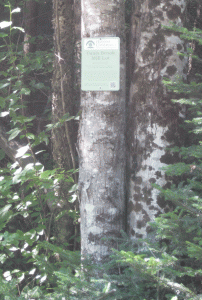 You’re about to visit the Conservancy’s smallest property, a 1.5 acre gem with a mysterious history. Hidden deep in the wild forests of Hanover’s northeast corner, at the foot of Moose Mountain, is the site of a 19th century sawmill on tiny Tunis Brook.
You’re about to visit the Conservancy’s smallest property, a 1.5 acre gem with a mysterious history. Hidden deep in the wild forests of Hanover’s northeast corner, at the foot of Moose Mountain, is the site of a 19th century sawmill on tiny Tunis Brook.- In winter, we suggest snowshoes rather than skis because of uneven ground at the mill lot. The trail, however, is fine for experienced backcountry skiers.
- The half-mile trail is marked with flagging and passes over private land on a right-of-way to the mill site. Conservancy volunteers maintain this trail.
- Dogs are welcome if under your control; please pick up after your pet.
- Snowmobiles, ATVs, and bicycles are not permitted.
Brief Hiking Directions
- Begin on the trail at R of the Conservancy sign.
- Follow the flagged half-mile-long right of way path for about 25 minutes to the Conservancy property, which is marked with a wooden sign.
- Explore the mill site and return by the same route to Goose Pond Road.
Full Hiking Directions
- Begin your hike on the trail that leaves to the R of the Conservancy sign, and note the time.
- The trail is mostly flat and follows an old tote road that can be traced to the mid-1800s. Here and there, saplings grow in the route; we leave them to discourage vehicles.
- The Mill Lot is part of a large block of contiguous forested wildlife habitat, much of it already conserved or owned by people with conservation intent. The Hanover Conservancy acquired the tiny parcel in 1994 with a gift of $5,000, to protect it from becoming the site of a vacation home deep in the forest. Close to Hanover’s Goodwin Forest, Town Forest, and also its McKinley Tract and Marshall Brook Wetlands (which the Conservancy helped the Town acquire in 1993 and 1977, respectively), the Mill Lot is a piece of the conservation puzzle in this wild corner of town.
- A few minutes’ walk from your car, cross a small drainage on a pair of logs. In snow, you might see only a slender birch handrail, placed by our volunteer. Another crossing comes up soon after.
- You’re passing through cool northern forest dominated by hemlock, spruce, and northern hardwoods such as yellow birch. Ruffed grouse live here year-round; look for their arrow-shaped tracks.
- Look for moose tracks too – this trail seems to be a moose right-of-way! We see moose sign every tim
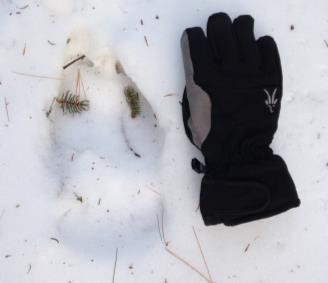 e we visit. Bobcat, bear, snowshoe hare, and coyote also frequent the area. Deer use a nearby wintering yard of dense softwoods. Small mammals include red squirrels, voles, moles, shrews, and mice.
e we visit. Bobcat, bear, snowshoe hare, and coyote also frequent the area. Deer use a nearby wintering yard of dense softwoods. Small mammals include red squirrels, voles, moles, shrews, and mice. - About 12 minutes’ walk from your car, the trail heads gently uphill and narrows, turning L through an intimate alley of young pines and hemlocks growing in the right-of-way. Their foliage muffles sound and you feel deliciously a part of the forest, privy to its secrets.
- The trail soon leads down into a little valley. Look for tracks of bounding snowshoe hare. Scattered on the snow might be spruce and fir tips, nibbled off by porcupine or red squirrels.
- At an opening, look for a big boulder at R and a flagged, striped maple just beyond. The maple bears wounds from moose and deer rubbing their antlers against its bark.
- About 20 minutes from your car, cross another small drainage.
- Five minutes later, bear R past another large boulder, at a tree marked with double red flagging. A wooden sign ahead signals your arrival at the Tunis Brook Mill Lot. The brook may be covered with snow, but you will hear its music beneath.
- To your R, the intriguing drylaid stone foundations of a sawmill are visible on the banks of Tunis Brook. Amos Kinne likely built the mill around 1849. Tax records suggest that the mill was active at least from 1850-1861. If snow obscures the mill ruins, resolve to return in spring to inspect them more fully!
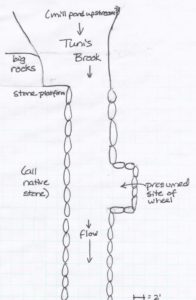 The foundation’s configuration suggests that this was an up-and-down sawmill, built over the stream and using waterpower to run a vertical, straight steel saw with coarse teeth – about six feet tall attached to a wooden frame that moved between two vertical fender posts. Because tiny Tunis Brook does not have much pitch here, water to push an overshot wheel and drive the saw was probably delivered via a millrace (trough or pipe of wood or iron) from a mill pond upstream, perhaps where a wetland is now.
The foundation’s configuration suggests that this was an up-and-down sawmill, built over the stream and using waterpower to run a vertical, straight steel saw with coarse teeth – about six feet tall attached to a wooden frame that moved between two vertical fender posts. Because tiny Tunis Brook does not have much pitch here, water to push an overshot wheel and drive the saw was probably delivered via a millrace (trough or pipe of wood or iron) from a mill pond upstream, perhaps where a wetland is now.- No records exist of the mill’s abandonment, but we presume that flooding destroyed the mill in 1862 since it was not assessed in that year. Floods were recorded in the Upper Valley on April 19, 1862, also February 10, 1867, and for four days in October, 1869 (the “Great Freshet”). Clearing of forests for pasturage and farming by the mid-1800s affected many streams, causing the “flashy” flows capable of washing out mills and their dams.
- Our 1.5 acre parcel, a grandfathered, non-conforming lot, has carried the name “mill lot” since at least 1860. The mystery surrounding its history grew as the chain of title came to a dead end in the late 1800s. We think it was lost in the estate of Kinne’s partner, Moses Colby, who lived on the Wolfeboro Road. The Town of Hanover auctioned it off a century later.
- The lot may be tiny, but observers have recorded 32 species of birds here, including hawks, three species of woodpeckers, and a variety of warblers. Here, you might find tracks of two members of the weasel family, the fisher and American mink.
- Now let’s visit another landmark – one of the largest glacial erratics in Hanover (a huge boulder deposited by the glacier as it melted). It’s nearby but out of sight of the mill.
- Follow the brook upstream, counting your paces. Within 75 paces, you’ll see the boulder looming ahead, and you’ll reach it in 75 more.
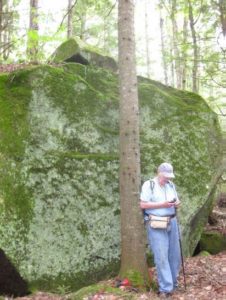
Geologist and Conservancy Board member Dick Birnie on a trip to evaluate the erratic - The erratic is composed of quartz, potassium feldspar, and black mica, with stripes of quartz. This boulder dropped out of glacial ice; its angular appearance indicates it did not roll along the ground. A smaller angular boulder on top is further evidence that it fell out of the ice. It came from nearby, possibly plucked off Winslow Ledge in Lyme. Its east side displays a flute, a classic glacial sculpture that was in place before it was plucked off the side of the cliff. Remains of a wooden ladder beneath hint that this once served as a hunting stand. (R: Geologist and former Conservancy Board member Dick Birnie on a trip to evaluate the erratic).
- Now follow the stream back down toward the Conservancy’s wooden sign. Halfway, you’ll see our small green boundary markers.
- Tunis Brook flows north to join Pressey Brook and eventually feeds Goose Pond and the Mascoma River. These waters are protected and purified by the healthy, mature forest sheltering Tunis Brook. This is a good thing – these waters ultimately become part of the City of Lebanon’s drinking water supply.
- The Conservancy’s studies of borings of trees on the mill lot show that its forest is composed of three age classes (about 140 years, 110 years, and 75 years). This suggests that the forest started to grow when the mill was abandoned, with two later disturbances that created openings for new trees. While the ’38 Hurricane might explain the youngest age class, what prompted the middle one is unclear.
- To find your way back, start at the wooden sign and follow the flagging. This time, keep an eye out for concentrations of tracks that indicate wildlife trails.
- Be sure to come back in the spring (before black fly season), when Tunis Brook will have much more to say!
February 2017, updated July 2020




